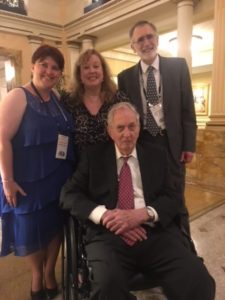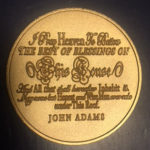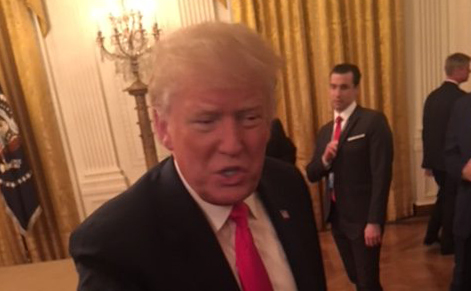For nearly three years, many Americans have held their collective breath watching the unfolding instability erupting from the White House.
As we witness the shattering of longstanding political and societal norms, we wonder if the next verbal attack or crisis will permanently upend the great American experiment. At what point does outrage begin to morph into apathy?
No one knows.
These days, many of us discuss our current political situation in personal conversations or while staring into computer or mobile screens. Few of us have the opportunity to talk to the president directly about our concerns. Last summer, while attending the 2018 Presidential Sites Summit, sponsored by the White House Historical Association, I had such a potential opportunity.
As I browsed the conference schedule, one event stood out among all the rest. We were invited to attend a White House reception with President and Mrs. Trump.
Instantly, a host of questions swirled through my mind. Would the president and first lady actually be there? Would I have the chance to meet the president? If so, would I be able to say anything to him?
My only other experience with a White House reception had been as a nineteen-year-old congressional intern in the summer of 1973, when I attended a reception on the South Lawn of the White House. The occasion was a welcome ceremony for the visiting Shah of Iran.
That day, I waited behind a rope barrier with the crowd as dignitaries arrived. When the Nixons and the shah appeared, they walked by on the other side of the rope some twenty feet from me. Nixon looked old. Watergate had etched deep lines in his face.
With that experience in mind, I wanted to prepare in the event I did get to shake President Trump’s hand. I didn’t want to squander the moment. But I vacillated about whether anything I might say could make a difference.
As a natural optimist, I hoped that something I might say could strike a responsive chord. Maybe a few carefully chosen words would prompt Trump to change his behavior.
I reminded myself that history often turns on seemingly small and inconsequential events. A story about one of our more obscure presidents, Chester Arthur makes this point.
When Arthur became president in 1881 after his predecessor James Garfield’s assassination, many Americans were justifiably concerned. Arthur had been a crony of corrupt, big-city political bosses. But as president, this man known for pushing patronage jobs pivoted and became a champion of civil-service reform.
What triggered his turnabout? Among Arthur’s few remaining personal papers (he had aides burn three garbage cans worth of his papers and letters after his presidency) were twenty-three letters from an unmarried, invalid woman in her thirties who wrote the new president, encouraging him to do the right thing.
“Rise to the emergency,” Julia Sand wrote. “Disappoint our fears. Force the nation to have faith in you. Show from the first that you have none but the purest aims. It may be difficult at once to inspire confidence, but persevere. In time— when you have given reason for it— the country will love & trust you.”
What could I say to emulate Julia Sand’s example? It would have to be short and to the point— tweet-sized. I asked friends: What should I say to Trump?
Their answers varied.
Some people said I should praise him for what he has done for the country. Others urged me to blast him for his policies and behavior. Still others suggested I ask Trump a question such as,
- “What would you most like to be remembered for as your best contribution to the USA and the world?”
- “Do you tweet with your thumbs, one index finger, or do you use a keyboard?”
And some people urged me not to go the White House at all.
For most of a month, I wrestled with what to say. I spent hours talking with others. I scribbled down ideas and phrases on scraps of paper. I typed some of my notes. Two broad themes emerged.
First, because Trump cares deeply about what others think about him, I wanted to say something about legacy—about the day when he would no longer control the narrative.
Second, in part to reflect my own faith, I wanted to appeal to spiritual impulses that might lurk in Trump’s psyche. I wanted to reach his heart through his humanity.
I didn’t know precisely what I would say at the reception when I arrived in Washington, D.C. but I started to condense my thoughts.
When I woke up the morning of the reception, I sat down at the desk in my ninth-floor hotel room and started writing, crossing out and adding in words. My first draft wasn’t right. It was also too messy to read. I started again. This time the message came out clearly and without edits.
At 253 characters, it was the right length— fewer than the standard 280 characters for a tweet:
“Mr. President, I’m praying for wisdom for you to do the right thing every day and to embrace truth and humility. History will have the last word on your legacy, and God himself will be the final judge of your deeds. Let me know if you ever want to talk.”
It embodied what I truly settled on saying to Trump.
- First, I would address him as “Mr. President,” a title respecting his office.
- Second, my words summoned spirituality by noting that “I’m praying” and reminding him that God will judge his deeds. John F. Kennedy, in his inaugural address, reminded his audience that “History will be the final judge of our deeds.” I changed that to God and sought to remind Trump that history (not a tweet) would establish his legacy.
- Finally, my prayers centered on three things in short supply when most consider this president: doing the right thing, embracing truth and acting with humility.
I folded the note in half and stuck it in my shirt pocket to look at, re-evaluate, and memorize in the hours before the 6:30 p.m. reception.
Later that afternoon at the White House staff greeted me and offered a glass of champagne. I walked up marble steps to the first-floor State Dining Room, where a pristine and dazzling display of appetizers and desserts had been laid out.
I picked up a white china plate, fork and white cloth napkin and began selecting food. My plate full, I looked for a place to sit. I noticed a few tables against the wall at the end of the buffet. A woman ahead of me was setting down her plate and graciously asked me to join her. Three others joined our table.
As we talked, I assumed we would hear an announcement about the president’s speech. I would have missed the speech entirely had I not noticed a large monitor near our table showing people gathering in the East Room.
Not wanting to miss the main event, I started for the East Room. Along the way one of my companions pointed out Chief of Staff John Kelly.
I also saw Vice President Mike Pence standing near the doorway talking with people gathered around him. Some were having their photos taken with him and his wife, Karen.
I waited a few moments for those in front of me to move away, then stood face to face with him.
I shook Pence’s hand, introduced myself and handed him my business card. He calmly held it in both hands and examined it carefully. He said he was intrigued by the name of my website, PresidentialHistory.com and promised to look at the site later.
As he pocketed my card, he introduced me to his wife. I smiled and shook her hand.
As I entered Entering the East Room, I noticed the space filling swiftly making it hard for me to get close to Trump.
Many in the room didn’t appear to be from the conference. Everyone wore business attire, but some looked more sophisticated than the conference attendees. Also, many were not sporting the conference nametag on a lanyard, a security requirement for attendees to even get onto the White House lawn.
As I took in the scene including several people wearing Keep America Great hats, I made my way to the front of the room, where I could detect a presidential podium and microphone from which Trump presumably would speak. People already were standing five or so deep behind from a rope separating the audience from the low stage.
Next to me was a woman I had met earlier at the conference. We chatted as the crowd filled in from behind, pushing us closer to those in front.
Maintaining my two square feet of floor space, I turned to watch more people pour into the room. Five feet behind me, I spotted Dr. Ben Carson, secretary of Housing and Urban Development.
I also saw Kellyanne Conway, counselor to Trump who had served as his third and final campaign manager. Her orange dress stood out in the sea of black and gray outfits.
Shortly before 7 p.m. a voice announced, “Ladies and gentlemen, the president of the United States.”
Trump and his wife, Melania, entered to my right, prompting lusty whoops and boisterous applause, not what I would expect from my more reserved conference colleagues. After snapping a photo of the presidential pair standing up front, I soon switched to video to record this mixture of pomp and spontaneity, holding my phone above those in front of me.
Melania spoke first, reading aloud remarks that reminded me of Jackie Kennedy’s White House stewardship in the early 1960s. She ended by deadpanning, “I know my husband would like to say a few words,” triggering loud laughter and cheers.
Moving to the podium, Trump kissed his wife’s cheek and joked, “Her poll numbers are so high, I’m going to try and get her to sign a document that she will never run against me. We don’t want any fear of that competition.”
He brought to the stage nearly a dozen dignitaries including Pence, Carson, Elaine Chao (transportation secretary), Betsy DeVos (education secretary), Steve Mnuchin (treasury secretary), Mick Mulvaney (then director of the Office of Management and Budget) and Robert Lighthizer (trade representative).
Trump interspersed his prepared remarks on the White House and the White House Historical Association with adjectives such as “special” and “incredible,” then went off script altogether, boasting of “new highs in polling and just about everything else you can imagine” and drawing more cheers by declaring the debatable claim that “our country has never been stronger financially or militarily.”
He saluted the presence of descendants of ten former presidents, then adlibbed at length by singling out President William McKinley, whom he called “the king of tariffs” who at a time of no federal income tax “left us a very wealthy nation.”
The crowd erupted in an ovation when Trump told us he would open the Oval Office— “the real deal,” “the most important room anywhere in the world”— for us to tour. A military aide later told me that in his three years at the White House he had never seen a president permit such a large group to see that office.
When the ceremony ended, the president and first lady stepped off the stage and made their way to those standing just behind the security rope. From my spot near the right side of the room, I inched my way forward as people began to leave.
My potential moment of contact was just seconds away. My mind raced, and I’m sure my heartbeat accelerated.
I debated with myself whether it would be physically possible for me to look Trump in the eye and shake his hand, much less speak to him. The noise was overwhelming.
Doubt about whether I had memorized my comments well enough also crept into my thoughts. I pulled out my folded note and skimmed its three sentences, trying to position myself closer to the rope.
I also pulled out a business card. Maybe I could hand Trump the card and my note?
He was making his way toward me, having brief and inaudible exchanges. This was happening fast.
I was almost to the rope, just a foot or so away, touching another rope to the right, where dignitaries were waiting. As Trump shook the hand of the person to my left and slightly in front of me, I turned sideways to squeeze in.
But given the noise and logistics, the notion of speaking to Trump simply vanished. I wasn’t close enough to do so without shouting and causing a scene.
Instinctively, my focus switched to stretching to get my hand in place to seize my first-ever chance to shake the hand of a president. (I had my photo taken with Jimmy Carter in October 2017 in Plains, Georgia, but protocol would not allow a handshake.)
Our hands did meet, briefly. In the tumult, however, I don’t think I looked at Trump’s face.
Mine was the last hand he shook in the general section before he moved to a narrow, five-foot space where he shook hands with dignitaries. I managed to snap a photo of him and his outstretched palm. In total, out of a packed room of maybe 400, he shook hands with perhaps thirty people, including me.
After I shook his hand, Melania passed by. I shook hers with the same contorted stretch of my arm.
Both had firm handshakes. Not surprisingly, the president’s hand was fleshier than the slender hand of the first lady, which made her handshake seem firmer than his.
And all at once, the moment was over. I let out a deep breath and turned away.
I admit that I was excited to have shaken a president’s hand. But I felt frustrated that I had not been able to speak to Trump.
Over and over I have second-guessed the scenario. If I had carved out a front-row position in the East Room at the outset instead of enjoying a conversation in the State Dining Room, I might have made verbal contact.
But to what end? It is highly unlikely, if not inconceivable, that any words, no matter how meticulously drafted and perfected, would have penetrated Trump’s consciousness in the moment.

Jenny Harville, Susan Tyler, Lyon Tyler, Mike Purdy
So I decided to do the next best thing. That night, I tweeted my comments to him. My 253 characters entered the twittersphere, addressed to @realDonaldTrump. It’s no surprise— to anyone, I’m sure— that Trump did not respond.
As I left the East Room, a brighter presidential moment came my way. I met the 93-year-old grandson of our tenth president, John Tyler, who served from 1841 to 1845. Later, back at the hotel, I had my photo taken with him, his daughter and the great granddaughter of our thirtieth president, Calvin Coolidge. Somehow, in the turmoil, connecting with the distant past was comforting.
Before leaving the White House, I returned to the State Dining Room looking for acquaintances, but all I saw were long lines around the dessert table, so I walked downstairs to join the tour of the Oval Office.
The tour line moved slowly. I peered into the Cabinet Room and Roosevelt Room. The Oval Office seemed smaller than in any photo I had seen. I wanted to leave my handwritten note and business card on Trump’s desk, but I didn’t think that would go over well with the Secret Service.
When we exited the White House, a staff member handed out White House medallions as gifts for our group. Later, I discovered its inscription was an oft-repeated quote from a letter by John Adams, our second president, about the newly constructed President’s House, as the White House was called originally, addressed to his wife, Abigail:
“I Pray Heaven to Bestow the Best of Blessings on THIS HOUSE and All that shall hereafter inhabit it. May none but Honest and Wise Men ever rule under this Roof.”
The same quote is carved into the mantel of the State Dining Room. I wonder if Trump ever sees or ponders it. Certainly, it is more eloquent than anything I could have said to him.
Or perhaps you could do better. If you had the chance to meet President Donald Trump, what would you say? And could it make a difference?
Note: I told parts of this story previously on this blog last summer reflecting on my experience of shaking President Trump’s hand. The article above was originally published on History News Network on October 20, 2019. Click here for a link to the 17 minute video I took of the president and first lady speaking in the East Room of the White House.


 Facebook
Facebook
 Twitter
Twitter
 LinkedIn
LinkedIn
 YouTube
YouTube
 Pinterest
Pinterest